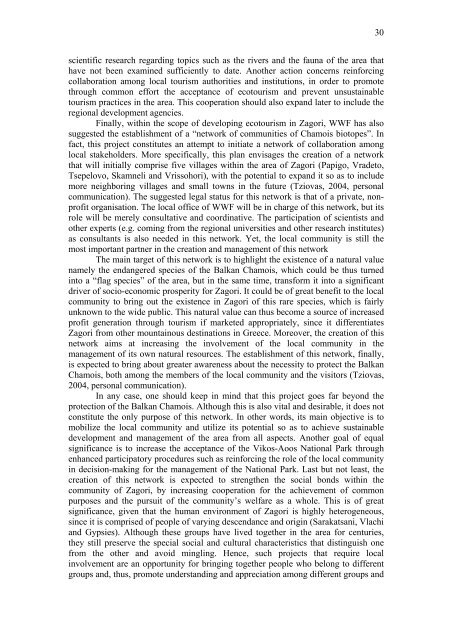Thesis title: âThe development of community-based ecotourism - lumes
Thesis title: âThe development of community-based ecotourism - lumes
Thesis title: âThe development of community-based ecotourism - lumes
You also want an ePaper? Increase the reach of your titles
YUMPU automatically turns print PDFs into web optimized ePapers that Google loves.
scientific research regarding topics such as the rivers and the fauna <strong>of</strong> the area thathave not been examined sufficiently to date. Another action concerns reinforcingcollaboration among local tourism authorities and institutions, in order to promotethrough common effort the acceptance <strong>of</strong> <strong>ecotourism</strong> and prevent unsustainabletourism practices in the area. This cooperation should also expand later to include theregional <strong>development</strong> agencies.Finally, within the scope <strong>of</strong> developing <strong>ecotourism</strong> in Zagori, WWF has alsosuggested the establishment <strong>of</strong> a “network <strong>of</strong> communities <strong>of</strong> Chamois biotopes”. Infact, this project constitutes an attempt to initiate a network <strong>of</strong> collaboration amonglocal stakeholders. More specifically, this plan envisages the creation <strong>of</strong> a networkthat will initially comprise five villages within the area <strong>of</strong> Zagori (Papigo, Vradeto,Tsepelovo, Skamneli and Vrissohori), with the potential to expand it so as to includemore neighboring villages and small towns in the future (Tziovas, 2004, personalcommunication). The suggested legal status for this network is that <strong>of</strong> a private, nonpr<strong>of</strong>itorganisation. The local <strong>of</strong>fice <strong>of</strong> WWF will be in charge <strong>of</strong> this network, but itsrole will be merely consultative and coordinative. The participation <strong>of</strong> scientists andother experts (e.g. coming from the regional universities and other research institutes)as consultants is also needed in this network. Yet, the local <strong>community</strong> is still themost important partner in the creation and management <strong>of</strong> this networkThe main target <strong>of</strong> this network is to highlight the existence <strong>of</strong> a natural valuenamely the endangered species <strong>of</strong> the Balkan Chamois, which could be thus turnedinto a “flag species” <strong>of</strong> the area, but in the same time, transform it into a significantdriver <strong>of</strong> socio-economic prosperity for Zagori. It could be <strong>of</strong> great benefit to the local<strong>community</strong> to bring out the existence in Zagori <strong>of</strong> this rare species, which is fairlyunknown to the wide public. This natural value can thus become a source <strong>of</strong> increasedpr<strong>of</strong>it generation through tourism if marketed appropriately, since it differentiatesZagori from other mountainous destinations in Greece. Moreover, the creation <strong>of</strong> thisnetwork aims at increasing the involvement <strong>of</strong> the local <strong>community</strong> in themanagement <strong>of</strong> its own natural resources. The establishment <strong>of</strong> this network, finally,is expected to bring about greater awareness about the necessity to protect the BalkanChamois, both among the members <strong>of</strong> the local <strong>community</strong> and the visitors (Tziovas,2004, personal communication).In any case, one should keep in mind that this project goes far beyond theprotection <strong>of</strong> the Balkan Chamois. Although this is also vital and desirable, it does notconstitute the only purpose <strong>of</strong> this network. In other words, its main objective is tomobilize the local <strong>community</strong> and utilize its potential so as to achieve sustainable<strong>development</strong> and management <strong>of</strong> the area from all aspects. Another goal <strong>of</strong> equalsignificance is to increase the acceptance <strong>of</strong> the Vikos-Aoos National Park throughenhanced participatory procedures such as reinforcing the role <strong>of</strong> the local <strong>community</strong>in decision-making for the management <strong>of</strong> the National Park. Last but not least, thecreation <strong>of</strong> this network is expected to strengthen the social bonds within the<strong>community</strong> <strong>of</strong> Zagori, by increasing cooperation for the achievement <strong>of</strong> commonpurposes and the pursuit <strong>of</strong> the <strong>community</strong>’s welfare as a whole. This is <strong>of</strong> greatsignificance, given that the human environment <strong>of</strong> Zagori is highly heterogeneous,since it is comprised <strong>of</strong> people <strong>of</strong> varying descendance and origin (Sarakatsani, Vlachiand Gypsies). Although these groups have lived together in the area for centuries,they still preserve the special social and cultural characteristics that distinguish onefrom the other and avoid mingling. Hence, such projects that require localinvolvement are an opportunity for bringing together people who belong to differentgroups and, thus, promote understanding and appreciation among different groups and30
















